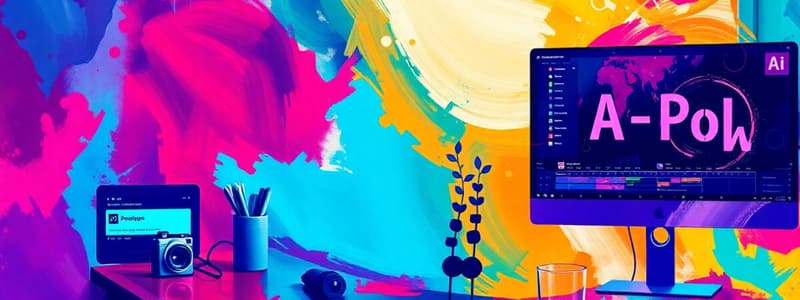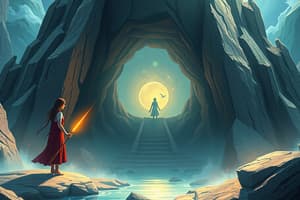Podcast
Questions and Answers
What is the function of a workspace in Adobe Premiere Pro?
What is the function of a workspace in Adobe Premiere Pro?
- It defines the layout of panels and tools used for editing. (correct)
- It automatically saves all project settings.
- It stores all video files imported into the project.
- It enables live streaming of video content.
Which of the following is NOT a way to customize a workspace in Adobe Premiere Pro?
Which of the following is NOT a way to customize a workspace in Adobe Premiere Pro?
- Undocking a panel to float in a new window.
- Moving panels into or out of groups.
- Arranging panels in a preferred layout.
- Changing the default file format for exports. (correct)
What does the montage principle create by combining independent images?
What does the montage principle create by combining independent images?
- Enhanced video clarity.
- A new meaning or interpretation. (correct)
- An automatic color correction.
- A seamless transition effect.
Which panel in Adobe Premiere Pro is essential for managing the files used in a project?
Which panel in Adobe Premiere Pro is essential for managing the files used in a project?
What type of tools are included in the tool panel of Adobe Premiere Pro?
What type of tools are included in the tool panel of Adobe Premiere Pro?
In what way does Adobe Premiere Pro handle video, audio, or still image files in a project?
In what way does Adobe Premiere Pro handle video, audio, or still image files in a project?
Which of the following describes grouped panels in Adobe Premiere Pro?
Which of the following describes grouped panels in Adobe Premiere Pro?
What is the main purpose of the editing tools in Adobe Premiere Pro?
What is the main purpose of the editing tools in Adobe Premiere Pro?
What is one of the primary responsibilities of the Modelling department during the production phase?
What is one of the primary responsibilities of the Modelling department during the production phase?
Which department primarily sets the stage for each scene of animation?
Which department primarily sets the stage for each scene of animation?
What is a dopesheet used for in the production phase?
What is a dopesheet used for in the production phase?
Which of the following statements about the production phase is true?
Which of the following statements about the production phase is true?
What does a layout represent in the context of animation production?
What does a layout represent in the context of animation production?
In 3D production, which stage is emphasized the most?
In 3D production, which stage is emphasized the most?
What activity is not typically included during the production phase of an animation project?
What activity is not typically included during the production phase of an animation project?
Which element is NOT a major activity undertaken during the animation production phase?
Which element is NOT a major activity undertaken during the animation production phase?
What is the main purpose of performing a Line Test in animation?
What is the main purpose of performing a Line Test in animation?
Which technique allows animators to view multiple frames simultaneously?
Which technique allows animators to view multiple frames simultaneously?
In the context of animation, what does a Walk Cycle primarily demonstrate?
In the context of animation, what does a Walk Cycle primarily demonstrate?
What is the role of Modellers in the animation process?
What is the role of Modellers in the animation process?
What distinguishes Organic Modellers from Hard-surface Modellers?
What distinguishes Organic Modellers from Hard-surface Modellers?
What is the last step mentioned in preparing a model for animation?
What is the last step mentioned in preparing a model for animation?
What is the significance of Onion Skinning in animation workflow?
What is the significance of Onion Skinning in animation workflow?
Which statement about the animation process is inaccurate?
Which statement about the animation process is inaccurate?
What is the primary purpose of the editing stage in post-production?
What is the primary purpose of the editing stage in post-production?
How does digital editing improve the editing process compared to traditional methods?
How does digital editing improve the editing process compared to traditional methods?
What role does an Editing Assistant play in the editing department?
What role does an Editing Assistant play in the editing department?
What is a key difference between video editing and sound editing in post-production?
What is a key difference between video editing and sound editing in post-production?
What impact does altering the soundtrack have on animation?
What impact does altering the soundtrack have on animation?
Why is editing considered a crucial step in the animation production process?
Why is editing considered a crucial step in the animation production process?
Which activity is generally NOT part of the video editing process?
Which activity is generally NOT part of the video editing process?
What does the use of non-linear video editing software typically allow editors to do?
What does the use of non-linear video editing software typically allow editors to do?
What does the work area bar in the Timeline panel specify?
What does the work area bar in the Timeline panel specify?
How can you change the display from time code to frame count in the Timeline panel?
How can you change the display from time code to frame count in the Timeline panel?
What happens when you delete a track in the Timeline panel?
What happens when you delete a track in the Timeline panel?
Where is the viewing area bar located in the Timeline panel?
Where is the viewing area bar located in the Timeline panel?
What can be done to arrange clips within the Timeline panel?
What can be done to arrange clips within the Timeline panel?
When adding audio tracks, what must you consider regarding the clips?
When adding audio tracks, what must you consider regarding the clips?
What is the purpose of zoom controls in the Timeline panel?
What is the purpose of zoom controls in the Timeline panel?
How do you specify the placement of added tracks in the Timeline panel?
How do you specify the placement of added tracks in the Timeline panel?
Which panel allows you to add markers at any point in your sound file?
Which panel allows you to add markers at any point in your sound file?
What happens when you click on an action in the History panel?
What happens when you click on an action in the History panel?
How can you return to a 100% view in the Editor panel?
How can you return to a 100% view in the Editor panel?
What does the Effects panel do?
What does the Effects panel do?
Which keys can be used to zoom in or out on the waveform in the Editor panel?
Which keys can be used to zoom in or out on the waveform in the Editor panel?
What functionality does the volume pop-up menu in the Editor panel provide?
What functionality does the volume pop-up menu in the Editor panel provide?
What is the primary function of the zoom navigator in the Editor panel?
What is the primary function of the zoom navigator in the Editor panel?
What does pressing the Delete button do in the History panel?
What does pressing the Delete button do in the History panel?
Flashcards
Layout in Animation
Layout in Animation
The process where artists create a visual blueprint for each scene, outlining character positions, movements and camera angles.
Dopesheet
Dopesheet
A specialized tool used in animation to plan timing and movement of characters, scenes, camera angles and audio details. It provides a visual timeline.
Modelling
Modelling
This phase in the animation process focuses on creating the actual figures, environment and objects that appear in the final animation.
Texturing
Texturing
Signup and view all the flashcards
Lighting in Animations
Lighting in Animations
Signup and view all the flashcards
Rigging in Animations
Rigging in Animations
Signup and view all the flashcards
Animation
Animation
Signup and view all the flashcards
Compositing in Animations
Compositing in Animations
Signup and view all the flashcards
Editing in Animation
Editing in Animation
Signup and view all the flashcards
Post-Production Sound Editing
Post-Production Sound Editing
Signup and view all the flashcards
Video Editing in Animation
Video Editing in Animation
Signup and view all the flashcards
Sound and Music Score
Sound and Music Score
Signup and view all the flashcards
Digital Non-Linear Video Editing
Digital Non-Linear Video Editing
Signup and view all the flashcards
Audio's Role in Storytelling
Audio's Role in Storytelling
Signup and view all the flashcards
Editing Assistants
Editing Assistants
Signup and view all the flashcards
Background Ambience and Music
Background Ambience and Music
Signup and view all the flashcards
Line Test
Line Test
Signup and view all the flashcards
Onion Skinning
Onion Skinning
Signup and view all the flashcards
Walk Cycle / Loops
Walk Cycle / Loops
Signup and view all the flashcards
Modelling in 3D
Modelling in 3D
Signup and view all the flashcards
Organic Modellers
Organic Modellers
Signup and view all the flashcards
Hard-surface Modellers
Hard-surface Modellers
Signup and view all the flashcards
Rigging
Rigging
Signup and view all the flashcards
Texture Painting
Texture Painting
Signup and view all the flashcards
What is Workspace?
What is Workspace?
Signup and view all the flashcards
What are the editing tools in Adobe Premiere Pro?
What are the editing tools in Adobe Premiere Pro?
Signup and view all the flashcards
How do you create a project in Adobe Premiere Pro?
How do you create a project in Adobe Premiere Pro?
Signup and view all the flashcards
What is the purpose of a Workspace?
What is the purpose of a Workspace?
Signup and view all the flashcards
What are individual panels?
What are individual panels?
Signup and view all the flashcards
What are grouped panels?
What are grouped panels?
Signup and view all the flashcards
How can you customize the workspace?
How can you customize the workspace?
Signup and view all the flashcards
What is the Project Panel?
What is the Project Panel?
Signup and view all the flashcards
History Panel
History Panel
Signup and view all the flashcards
Work Area Bar
Work Area Bar
Signup and view all the flashcards
Editor Panel
Editor Panel
Signup and view all the flashcards
Zoom Navigator
Zoom Navigator
Signup and view all the flashcards
Zoom Controls
Zoom Controls
Signup and view all the flashcards
Effects Panel
Effects Panel
Signup and view all the flashcards
Viewing Area Bar
Viewing Area Bar
Signup and view all the flashcards
Markers Panel
Markers Panel
Signup and view all the flashcards
Video and Audio Tracks
Video and Audio Tracks
Signup and view all the flashcards
New Video & Audio Tracks
New Video & Audio Tracks
Signup and view all the flashcards
Volume Pop-Up Menu
Volume Pop-Up Menu
Signup and view all the flashcards
Creating Effects
Creating Effects
Signup and view all the flashcards
Deleting Tracks
Deleting Tracks
Signup and view all the flashcards
Add Tracks Menu
Add Tracks Menu
Signup and view all the flashcards
Interview.wav
Interview.wav
Signup and view all the flashcards
Audio Track Compatibility
Audio Track Compatibility
Signup and view all the flashcards
Study Notes
Unit 1: 3D Production Pipeline
- This workbook covers the 3D production pipeline, specifically for Class 12 students in a Media and Entertainment course. The National Skill Qualification Framework (NSQF) Level 4 is relevant (12th grade)
- PSS Central Institute of Vocational Education, a constituent unit of NCERT, developed this workbook.
- The copyright for this publication is protected by the copyright act, and unauthorized reproduction is prohibited.
Acknowledgements
- The Ministry of Human Resource Development (MHRD) funded the development of curricula for classes 9 to 12 (NSQF Levels 1-4).
- The Institute thanks NSDC and MESC for providing QP's and NOS, which were used to create the course content.
- Subject matter experts, reviewers, and resource persons contributed to the development of the course material.
- Prof. R.B. Shivagunde and the project's Standing Committee provided valuable guidance to the project.
- Shri Sourabh Kulparia and Shri Meet Vishwakarma supported with typesetting and composing the material.
Introduction
- 2D animation uses bitmap or vector graphics. Automated processes include interpolated morphing, onion skinning and rotoscoping.
- 3D animation is a digital version of 2D. Animations are created through manipulating a series of still images (frames).
- The 3D computer generated production process emphasizes the importance of a smooth workflow. This includes design, modeling, rigging, touch up and final output in the form of a video or film.
Session 1: Pre-Production
- Pre-production involves initial planning before actual production.
- Includes: storyboard, layouts, model sheets, and animatics. These components help finalize the storyline and visually communicate ideas.
Session 2: Production 1
- The production phase requires performing tasks like layout, modeling, texturing, lighting, rigging, and animation.
- Layout Artists produce 3D versions of the storyboard. They determine lighting, camera angles and positioning of characters/objects within each scene, serving as a vital reference for the entire team.
- Background Artists create the settings for each scene.
Session 2: Production 2
- This session is about lighting and rigging in 3D animation.
- Lighting artists plan and coordinate the lighting in scenes, ensuring consistency in mood and believability.
- Rigging is the process of adding "bones" (digital skeletal structure) to characters. The process helps in generating believable and flexible character movements.
Session 2: Texturing
- Lighting, colour balance, and mood are important considerations during 3D animation.
- Computer-generated imagery (CGI) should look photorealistic, matching live-action plates.
- Real-time, digital processes let texturing artists create or edit textures.
- Texturing artists match textures to conceptual artwork.
Session 3: Production 3, 4
- These sessions specifically discuss the post-production activities, including rendering, compositing, sound (editing and scoring), and video (editing) processes, that happen after initial production.
Table of Contents, Acknowledgements and Prefaces
- This part focuses on the content organization of the manual.
- Lists the contents of each section.
- Acknowledgments are given to those who contributed.
- Introductory remarks explain the overall goals and purpose of these materials and projects.
Glossary
- This section provides definitions for technical terms used throughout the study materials to assist students.
Suggested Reading
- This section provides suggested reference materials and resources that students can use for furthering their knowledge on the concepts discussed in the workbook.
Studying That Suits You
Use AI to generate personalized quizzes and flashcards to suit your learning preferences.




